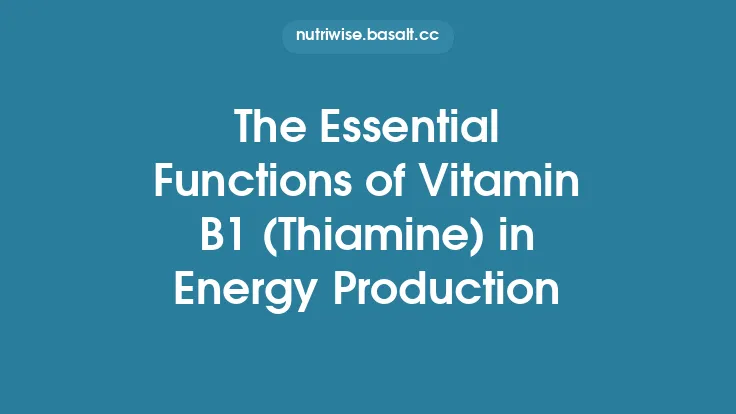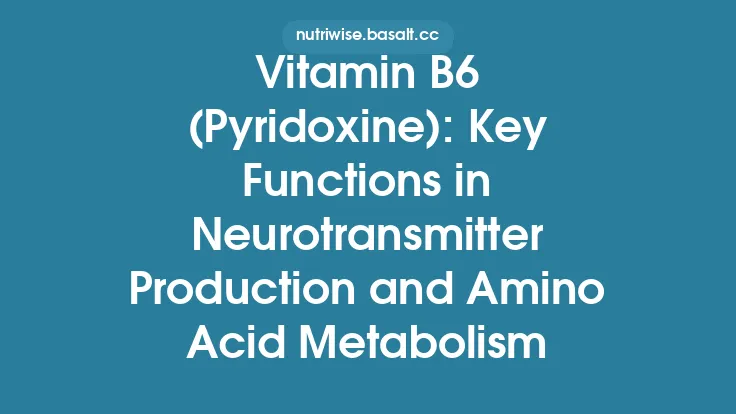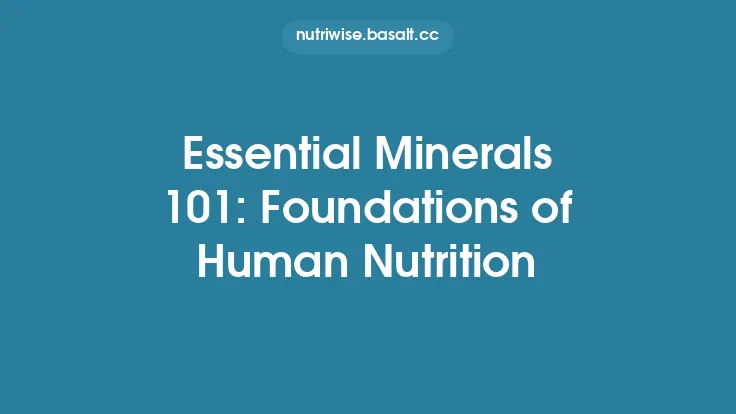Essential minerals are far more than static building blocks; they are dynamic participants that drive the biochemical engines of our bodies. Throughout the day, trillions of enzymatic reactions occur, each requiring precise coordination of substrates, cofactors, and regulatory signals. Among the most critical of these cofactors are the essential minerals—trace and macro‑elements that act as structural stabilizers, catalytic centers, and electrochemical mediators. Understanding how these minerals integrate into metabolic pathways provides a foundation for appreciating why even subtle imbalances can ripple through energy production, macronutrient processing, and overall physiological performance.
Metabolic Pathways Dependent on Mineral Cofactors
Every metabolic cascade—whether it breaks down glucose for quick energy or synthesizes complex lipids for cellular membranes—relies on enzymes that are either directly dependent on mineral ions or whose activity is modulated by them. The most common modes of interaction include:
| Interaction Type | Example Mineral | Representative Enzyme(s) | Metabolic Context |
|---|---|---|---|
| Structural cofactor | Zn²⁺ | Alcohol dehydrogenase, carbonic anhydrase | Alcohol metabolism; CO₂ transport |
| Catalytic metal center | Mg²⁺ | ATP‑dependent kinases (e.g., hexokinase, phosphofructokinase) | Glycolysis, glycogen synthesis |
| Allosteric regulator | Fe²⁺/Fe³⁺ | Cytochrome P450 enzymes | Steroid hormone synthesis, drug metabolism |
| Electron carrier | Cu⁺/Cu²⁺ | Cytochrome c oxidase (Complex IV) | Oxidative phosphorylation |
| Cofactor for radical chemistry | Mn²⁺ | Manganese superoxide dismutase (MnSOD) | Antioxidant defense, mitochondrial metabolism |
| Acid‑base buffer | Ca²⁺ | Calmodulin‑dependent kinases | Signal transduction linking metabolism to calcium fluxes |
These interactions are not isolated; they form a web where the activity of one mineral‑dependent enzyme can influence downstream steps, creating a cascade of metabolic consequences.
Minerals in Energy Production and ATP Synthesis
The production of adenosine triphosphate (ATP) is the cornerstone of cellular metabolism, and several essential minerals are indispensable for each stage of this process.
- Glycolysis and the Tricarboxylic Acid (TCA) Cycle
- Mg²⁺ stabilizes the phosphate groups of ATP and ADP, enabling kinases such as phosphofructokinase‑1 (PFK‑1) to catalyze phosphoryl transfer.
- Mn²⁺ can substitute for Mg²⁺ in certain dehydrogenases, ensuring continuity of the TCA cycle under variable mineral availability.
- Oxidative Phosphorylation
- Fe²⁺/Fe³⁺ are integral to the iron‑sulfur clusters of Complex I (NADH dehydrogenase) and Complex III (cytochrome bc₁ complex), facilitating electron shuttling from NADH/FADH₂ to ubiquinone.
- Cu⁺/Cu²⁺ reside in the catalytic core of Complex IV (cytochrome c oxidase), where they accept electrons from cytochrome c and reduce molecular oxygen to water, a step that drives the proton gradient essential for ATP synthase.
- Zn²⁺ is a structural component of mitochondrial matrix enzymes such as succinate dehydrogenase (Complex II), linking the TCA cycle directly to the electron transport chain.
- ATP Synthase Function
- Mg²⁺ binds to ADP and inorganic phosphate (Pi) within the F₁ domain, positioning them for condensation into ATP. The presence of adequate Mg²⁺ is therefore a rate‑limiting factor for the final step of oxidative phosphorylation.
Collectively, these minerals ensure the seamless flow of electrons, the maintenance of the proton motive force, and the efficient synthesis of ATP—processes that are fundamentally non‑negotiable for life.
Role of Minerals in Carbohydrate Metabolism
Carbohydrate handling—from ingestion to storage—relies on a suite of mineral‑dependent enzymes:
- Hexokinase and Glucokinase: Both require Mg²⁺ to phosphorylate glucose, the first irreversible step of glycolysis. In the liver, glucokinase’s lower affinity for glucose allows it to act as a glucose sensor, a function modulated by Mg²⁺ availability.
- Phosphofructokinase‑1 (PFK‑1): This key regulatory enzyme is allosterically activated by fructose‑2,6‑bisphosphate and inhibited by ATP. Mg²⁺ is essential for the binding of ATP and ADP, influencing the enzyme’s sensitivity to these effectors.
- Glycogen Synthase: The enzyme that polymerizes glucose into glycogen requires a Mg²⁺‑ATP complex for its activity. Conversely, glycogen phosphorylase, which mobilizes stored glycogen, is activated by a cascade that includes Ca²⁺‑dependent protein phosphatases, linking calcium signaling to carbohydrate release.
- Aldolase and Triose Phosphate Isomerase: Both contain Zn²⁺ at their active sites, stabilizing the transition states of carbonyl intermediates during the cleavage of fructose‑1,6‑bisphosphate.
These mineral‑enzyme relationships illustrate how the body fine‑tunes glucose flux, ensuring that energy supply matches demand across tissues.
Minerals in Lipid Metabolism
Fatty acid synthesis, β‑oxidation, and cholesterol homeostasis are heavily mineral‑dependent:
- Acetyl‑CoA Carboxylase (ACC): The rate‑limiting enzyme of de novo lipogenesis requires biotin as a cofactor, but its activity is contingent on Mg²⁺‑ATP for phosphorylation by AMP‑activated protein kinase (AMPK). Mg²⁺ thus indirectly governs the switch between fatty acid synthesis and oxidation.
- Fatty Acid Synthase (FAS): This multi‑domain enzyme utilizes NADPH and requires Zn²⁺ for the condensation reactions that elongate the carbon chain.
- Carnitine Palmitoyltransferase I (CPT‑I): The gateway to mitochondrial β‑oxidation is regulated by malonyl‑CoA, whose synthesis is Mg²⁺‑dependent. Additionally, Ca²⁺ influx into mitochondria can stimulate CPT‑I activity, linking calcium signaling to fatty acid catabolism.
- HMG‑CoA Reductase: The master regulator of cholesterol synthesis contains a Fe²⁺‑dependent active site that reduces HMG‑CoA to mevalonate. Statins, the widely used cholesterol‑lowering drugs, competitively inhibit this enzyme, underscoring the clinical relevance of its mineral cofactor.
Through these mechanisms, essential minerals orchestrate the balance between lipid storage, mobilization, and synthesis, influencing everything from membrane composition to hormone production.
Minerals in Protein Synthesis and Amino Acid Metabolism
Amino acid catabolism and the assembly of new proteins are not exempt from mineral influence:
- Ribosomal Function: Mg²⁺ stabilizes ribosomal RNA (rRNA) structures, ensuring accurate translation. The Mg²⁺ concentration within the cytosol directly affects the fidelity of codon‑anticodon pairing.
- Aminoacyl‑tRNA Synthetases: These enzymes, which charge tRNA molecules with their respective amino acids, require Zn²⁺ for structural integrity and catalytic activity.
- Transamination Reactions: The conversion of amino acids to keto acids (and vice versa) is mediated by aminotransferases that depend on pyridoxal‑5′‑phosphate (vitamin B₆) but also require Mg²⁺ as a cofactor for the binding of the amino donor substrate.
- Urea Cycle Enzymes: Ornithine transcarbamylase and argininosuccinate synthase both contain Mn²⁺ at their active sites, facilitating the detoxification of ammonia generated during amino acid deamination.
These mineral‑dependent steps ensure that protein turnover, nitrogen balance, and the synthesis of non‑essential amino acids proceed efficiently.
Minerals as Regulators of Hormonal and Enzymatic Activity
Beyond direct catalytic roles, essential minerals modulate hormonal pathways that, in turn, dictate metabolic flux:
- Calcium (Ca²⁺) and Hormone Secretion
Calcium influx into pancreatic β‑cells triggers insulin exocytosis. The subsequent insulin signaling cascade promotes glucose uptake via GLUT4 translocation, a process that also requires Mg²⁺‑dependent kinases (e.g., Akt).
- Zinc (Zn²⁺) and Insulin Mimicry
Zn²⁺ is co‑secreted with insulin in crystalline granules, stabilizing the hormone and extending its half‑life. Moreover, Zn²⁺ can activate insulin‑like growth factor (IGF) pathways, influencing anabolic metabolism.
- Iron (Fe) and Thyroid Hormone Metabolism
Thyroid peroxidase, an Fe‑containing enzyme, catalyzes the iodination of tyrosine residues in thyroglobulin, a prerequisite for the synthesis of T₃ and T₄. Thyroid hormones are master regulators of basal metabolic rate, mitochondrial biogenesis, and thermogenesis.
- Copper (Cu) and Catecholamine Synthesis
Dopamine β‑hydroxylase, a Cu‑dependent enzyme, converts dopamine to norepinephrine. Catecholamines stimulate glycogenolysis and lipolysis, linking copper status to acute energy mobilization.
Through these indirect pathways, mineral status can amplify or dampen hormonal signals that orchestrate whole‑body metabolism.
Interplay Between Minerals and Vitamins in Metabolic Networks
Metabolism is a collaborative arena where minerals and vitamins co‑operate:
- Magnesium–Vitamin B Complex: Many B‑vitamin‑dependent enzymes (e.g., pyruvate dehydrogenase, α‑ketoglutarate dehydrogenase) require Mg²⁺ as a cofactor for the binding of thiamine pyrophosphate (TPP) or lipoic acid. Deficiency in either component can bottleneck the entry of carbohydrates into the TCA cycle.
- Zinc–Vitamin A: Zinc is essential for the activity of retinol‑binding protein, which transports vitamin A to target tissues. Vitamin A, in turn, regulates genes involved in lipid metabolism and adipocyte differentiation.
- Copper–Vitamin C: Ascorbate (vitamin C) reduces Cu²⁺ to Cu⁺, a step necessary for the activity of lysyl oxidase, an enzyme that cross‑links collagen and elastin. While not a classic metabolic pathway, this interaction influences tissue integrity, indirectly affecting metabolic efficiency (e.g., vascular compliance).
- Iron–Vitamin B₁₂: The synthesis of methylmalonyl‑CoA mutase, a B₁₂‑dependent enzyme, requires Fe‑sulfur clusters. This enzyme converts methylmalonyl‑CoA to succinyl‑CoA, feeding into the TCA cycle and linking fatty acid catabolism to energy production.
These synergistic relationships underscore the necessity of viewing micronutrients as an integrated system rather than isolated entities.
Implications of Mineral Deficiencies on Metabolic Health
When essential minerals fall short of physiological needs, metabolic disturbances emerge:
| Deficiency | Primary Metabolic Consequence | Clinical Correlate |
|---|---|---|
| Mg²⁺ | Impaired ATP utilization, reduced activity of glycolytic kinases, blunted insulin signaling | Muscle cramps, insulin resistance, arrhythmias |
| Zn²⁺ | Diminished insulin storage/release, compromised carbohydrate metabolism | Delayed wound healing, dyslipidemia |
| Fe | Reduced activity of cytochromes, lower oxidative phosphorylation capacity | Fatigue, reduced VO₂ max, impaired thermogenesis |
| Cu | Decreased Complex IV activity, lower aerobic ATP yield | Neuromuscular weakness, anemia |
| Mn | Compromised antioxidant defense (MnSOD), mitochondrial dysfunction | Neurodegeneration, impaired fatty acid oxidation |
| Ca²⁺ | Disrupted hormone secretion (insulin, glucagon), altered signal transduction | Hyperglycemia, metabolic syndrome |
Even subclinical deficiencies can subtly shift metabolic set points, predisposing individuals to chronic conditions such as type 2 diabetes, non‑alcoholic fatty liver disease, and sarcopenia. Recognizing these links reinforces the importance of maintaining adequate mineral status throughout the lifespan.
Research Frontiers and Emerging Insights
The field of mineral metabolism continues to evolve, with several promising avenues:
- Metallomics and Systems Biology
Advanced mass‑spectrometry techniques now enable quantification of the entire mineral complement (the “metallome”) within cells and tissues. Integrating metallomic data with transcriptomics and metabolomics is revealing previously hidden regulatory loops—for example, how transient fluctuations in intracellular Zn²⁺ modulate the activity of metabolic transcription factors such as MTF‑1.
- Nanoparticle Delivery of Minerals
Researchers are exploring biocompatible nanocarriers that can target specific organelles (e.g., mitochondria) to deliver Mg²⁺ or Fe directly where they are most needed, potentially enhancing ATP production in disease states like heart failure.
- Genetic Variants Influencing Mineral Utilization
Genome‑wide association studies (GWAS) have identified polymorphisms in genes encoding mineral transporters (e.g., SLC30A8 for Zn²⁺) that correlate with altered glucose tolerance. Understanding these variants may pave the way for personalized mineral supplementation strategies.
- Cross‑Talk Between Mineral Sensing Pathways and Metabolic Sensors
Emerging evidence suggests that the calcium‑sensing receptor (CaSR) interacts with AMP‑activated protein kinase (AMPK), linking extracellular mineral concentrations to intracellular energy status. Deciphering this cross‑talk could uncover novel therapeutic targets for metabolic disorders.
These frontiers illustrate that the role of essential minerals in metabolism is not static; it is a vibrant research landscape with direct implications for nutrition science, clinical practice, and public health.
In sum, essential minerals are integral to every facet of metabolic function—from the minute catalytic steps that split glucose molecules to the grand hormonal orchestrations that dictate energy balance. Their influence permeates carbohydrate, lipid, and protein pathways, intertwines with vitamin‑dependent processes, and modulates the very signals that tell cells when to store or expend energy. Maintaining optimal mineral status is therefore not merely a matter of preventing deficiency diseases; it is a cornerstone of metabolic resilience and long‑term health.





